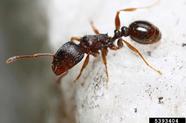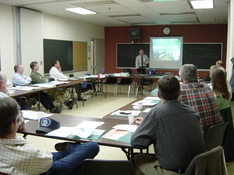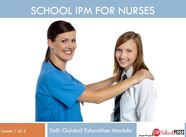News
 When Pavement Ants Come Indoors
The pavement ant (scientific
name Tetramorium
caespitum) is commonly found in
Maine schools. It is ‘from away’—probably brought here in soil carried from
Europe as ballast in the holds of merchant vessels during the 1700s to 1800s. It
is a soil-nesting species. Fortunately, it does not damage buildings nor does
it bite or spread disease.
Pavement ants are dark brown to
black and small (workers are about 1/16-1/8” long. The winged ‘swarmer’ form of
this ant is about twice as big). Both workers and swarmers have parallel
furrows or lines on the head and thorax but you may need a strong magnifier or
microscope to see them. Winged reproductive ants typically swarm in the spring
but have been known to emerge any time of the year in heated structures. It is
not uncommon to see swarming in late fall and into February even in Maine.
Most colonies are located under
sidewalks, building slabs, and large rocks but occasionally nest in walls or
ceiling voids. Ants often enter buildings through cracks in the concrete slab
or foundation. It is common to see sand piles and small soil particles near these
cracks where the ants deposit debris from excavated nests. Similar piles are
seen in the warmer months at the cracks in sidewalks.
Pavement ants feed on a variety
of sweets, grease, dead insects, and small seeds, but nearly any morsel of food
that falls to the floor will be eaten or carried back to the nest.
Although ants in school
buildings are not generally cause for alarm, they can be a distracting
nuisance. Here’s what to do about ants in school buildings.
IPM
Steps
1.
Inspect, Identify, and Monitor. Pavement ants are most active at night but can be active in the
day, especially in spring.
· Inspect along walls
(interior and exterior) to find ants, determine where ants are likely entering
and find out what is attracting them. They secrete and follow scent trails to
and from food sources. Ants may trail each other along cove molding, electrical
wires, conduit or plumbing.
· Look for ants and
telltale accumulations of soil inside the building or outdoors along foundations,
doors and walkways. Use a flashlight to look behind, under and around equipment
and furniture, especially in classrooms, break rooms and kitchens.
· When ants are sighted,
collect a few and take them to your county Extension office for identification.
· Strategically placed
sticky cardboard traps can also help pinpoint ant activity areas and entryways
so you can focus on those areas to inspect, clean and seal.
· Instruct students and
staff to report and record ant sightings on the Pest Sighting Log in the Pest
Management Activity Logbook.
2.
Clean and Seal. IPM for indoor pests is
always a combination of exclusion (seal them out) and sanitation (deep clean to
eliminate greasy and sugary residues, crumbs, dead insects and other foods).
· Keep food-use areas
extremely clean, making sure to keep food debris from being embedded in corners
and along baseboards.
· Clean up spills promptly
and keep all food in pest-proof containers.
· Search out and eliminate
stashes of soda and juice bottles.
· Seal all cracks and
holes in foundation, walls, windows, weather-stripping, door sweeps and
screens.
· Remove cove molding and
seal cracks at the floor/wall interface if needed to keep ants from entering
via cracks in the slab under the building.
3. Pesticide Baits if
Needed. If reducing any source
of food debris or grease inside your building, and sealing entryways fails to
eliminate ant activity, talk with a licensed pest management provider
about strategically placing pesticide-laced bait.
· Pesticide use—even ant ‘traps’
and ‘cups’ that contain pesticide-laced ant bait is permitted only by a
licensed applicator.
· Pesticide-containing ant
baits are slow-acting to allow ants to carry it back as food to the nest and
slowly kill the colony.
· Liquid or gel baits are the
most effective formulations and can be placed in a sealed bait station (ants
enter through small holes) placed in inaccessible locations or injected into
cracks and crevices. Placement is critical—be sure it is placed only where ants
are active.
· Bait must be kept out of
reach of children--do not use ant bait
granules in or around schools.
· Don’t expect to see dead
ants immediately. Rather, you should see the ants slowly disappear over 1-2
weeks. If there are many ants, bait may need to be replenished.
4. Keep Records and Evaluate. Was the tactic successful? Record the date
pests were first noted, and the tactics you used, and its success in your Pest
Management Activity Log.
Find
more tips and record keeping forms at www.maine.gov/schoolipm
|
Clean
and Disinfect Schools To Help Slow the Spread of Flu
According to health experts, the 2018 flu outbreak is the worst in a decade. School staff play a critical role in preventing the spread of flu and other infectious diseases. Are you school staff up to speed on proper cleaning and disinfection? .
1. Know the difference between cleaning, disinfecting, and
sanitizing
Cleaning removes germs,
dirt, and impurities from surfaces or objects. Cleaning works by using soap (or
detergent) and water to physically remove germs from surfaces. This process
does not necessarily kill germs, but by removing them, it lowers their numbers
and the risk of spreading infection. Disinfecting kills germs on
surfaces or objects. Disinfecting works by using chemicals to kill germs on
surfaces or objects. This process does not necessarily clean dirty surfaces or
remove germs, but by killing germs on a surface after cleaning, it can further
lower the risk of spreading infection. Sanitizing lowers the number of germs on
surfaces or objects to a safe level, as judged by public health standards or
requirements. This process works by either cleaning or disinfecting surfaces
or objects to lower the risk of spreading infection.
2. Clean and disinfect surfaces and objects that are touched
often
Follow your
school’s standard procedures for routine cleaning and disinfecting. Typically,
this means daily sanitizing surfaces and objects that are touched often, such
as desks, countertops, doorknobs, computer keyboards, hands-on learning items,
faucet handles, phones, and toys. Some schools may also require daily
disinfecting these items. Standard procedures often call for disinfecting
specific areas of the school, like bathrooms.
Immediately
clean surfaces and objects that are visibly soiled. If surfaces or objects are
soiled with body fluids or blood, use gloves and other standard precautions to
avoid coming into contact with the fluid. Remove the spill, and then clean and
disinfect the surface.
3.
Simply do routine cleaning and disinfecting
It is
important to match your cleaning and disinfecting activities to the types of
germs you want to remove or kill. Most studies have shown that the flu virus
can live and potentially infect a person for up to 48 hours after being
deposited on a surface. However, it is not necessary to close schools to clean
or disinfect every surface in the building to slow the spread of flu. Also, if
students and staff are dismissed because the school cannot function normally
(e.g., high absenteeism during a flu outbreak), it is not necessary to do extra
cleaning and disinfecting.
Flu viruses
are relatively fragile, so standard cleaning and disinfecting practices are
sufficient to remove or kill them. Special cleaning and disinfecting processes,
including wiping down walls and ceilings, frequently using room air
deodorizers, and fumigating, are not necessary or recommended. These processes
can irritate eyes, noses, throats, and skin; aggravate asthma; and cause other
serious side effects.
4. Clean and disinfect correctly
Always
follow label directions on cleaning products and disinfectants. Wash surfaces
with a general household cleaner to remove germs. Rinse with water, and follow
with an EPA-registered disinfectant to kill germs. Read the label to make sure
it states that EPA has approved the product for effectiveness against influenza
A virus.
If a surface
is not visibly dirty, you can clean it with an EPA-registered product that both
cleans (removes germs) and disinfects (kills germs) instead. Be sure to read
the label directions carefully, as there may be a separate procedure for using
the product as a cleaner or as a disinfectant. Disinfection usually requires
the product to remain on the surface for a certain period of time (e.g.,
letting it stand for 3 to 5 minutes).
Use
disinfecting wipes on electronic items that are touched often, such as phones
and computers. Pay close attention to the directions for using disinfecting
wipes. It may be necessary to use more than one wipe to keep the surface wet
for the stated length of contact time. Make sure that the electronics can
withstand the use of liquids for cleaning and disinfecting.
5.
Use products safely
Pay close
attention to hazard warnings and directions on product labels. Cleaning
products and disinfectants often call for the use of gloves or eye protection.
For example, gloves should always be worn to protect your hands when working
with bleach solutions.
Do not mix
cleaners and disinfectants unless the labels indicate it is safe to do so.
Combining certain products (such as chlorine bleach and ammonia cleaners) can
result in serious injury or death.
Ensure that
custodial staff, teachers, and others who use cleaners and disinfectants read
and understand all instruction labels and understand safe and appropriate use.
This might require that instructional materials and training be provided in
other languages.
6. Handle waste properly
Follow your
school’s standard procedures for handling waste, which may include wearing
gloves. Place no-touch waste baskets where they are easy to use. Throw
disposable items used to clean surfaces and items in the trash immediately
after use. Avoid touching used tissues and other waste when emptying waste
baskets. Wash your hands with soap and water after emptying waste baskets and
touching used tissues and similar waste.
-from Texas Department
of State Health Services http://www.dshs.texas.gov/txflu/cleaningschools.aspx
 Register Now for 2018 Comprehensive IPM Workshops! (all workshops are free and open to all)
Feb 22, 2018, 8:00am-11:00am, United Technologies
Center, 200 Hogan Rd, Bangor, ME. REGISTER
Apr 18, 2018, 9:00 am-noon, Sumner High School,
2456 Route 1, Sullivan, ME. REGISTER
June 28, 2018, 8:30am-noon, in conjunction with EPMA Conference, Waterville High School, 1 Brooklyn
Ave, Waterville, ME. REGISTER
Want to host a Comprehensive IPM Workshop at your school? Contact Kathy Murray, or call 287-7616 to inquire.
Remember, if you are the IPM Coordinator for your schools you must complete the following trainings:
-
Complete the on-line Initial IPM Training Module (within 1 month of appointment as IPM Coordinator
and review periodically to refresh yourself on the requirements for
notices, signage and record-keeping.
-
Attend a Comprehensive IPM Workshop (within 1 year of appointment). Want to host a
Comprehensive IPM Workshop at your school? Contact Kathy
Murray, or call 287-7616 to schedule it.
-
Complete 1 hr/year of IPM
Continuing Education. NEW: Now
you can earn 1-hr of Continuing Education with free
on-line Professional Development Training available at StopSchoolPests.org!
Or watch a webinar or participate in any other training related to IPM or
school facilities management.
Keep your training certificates and/or your own training records in the training
section of your Pest Activity Logbook.
|
 Are tick and mosquitoes a concern at your schools? Are you looking for up-to-date protocols for bed bugs? Wondering whats new with head lice? Find resources at www.maine.gov/schoolipm.
New Tools Coming! With funding from the NE IPM Center new resources such as wallet cards, posters, parent letters, and webinars on health-pest topics will soon be available for school nurses.
But no need to wait, there are excellent free health pest training modules especially for school nurses already available at www.stopschoolpests.org. Register (its free), complete the training modules, and earn a certificate today!
Contact Kathy.murray@maine.gov, or 207-287-7616, to get announcements of new offerings or to discuss your pest concerns. We want to hear from you!
|

Getting ready for spring? Find hundreds of lessons and activities on insects, plants, invasive species, gardening and more at www.maine.gov/schoolipm (click on Teacher Resources in the left side navigation bar).
The National Agriculture in the Classroom Conference is coming to Portland, Maine! June 26-29, 2018. FMI: https://www.agclassroom.org/conferences/
Lots of new things happening in the Maine School Garden Network! Spring conference planning is underway. Free compost is available for school gardens too. FMI: www.msgn.org
Find us on Facebook: No More Pests for Teachers and Kids
|
Questions/Comments? Contact us!
Email: kathy.murray@maine.gov
Phone: 207-287-7616
Get this from a friend? Subscribe Now! Or visit maine.gov/schoolipm to subscribe.
|